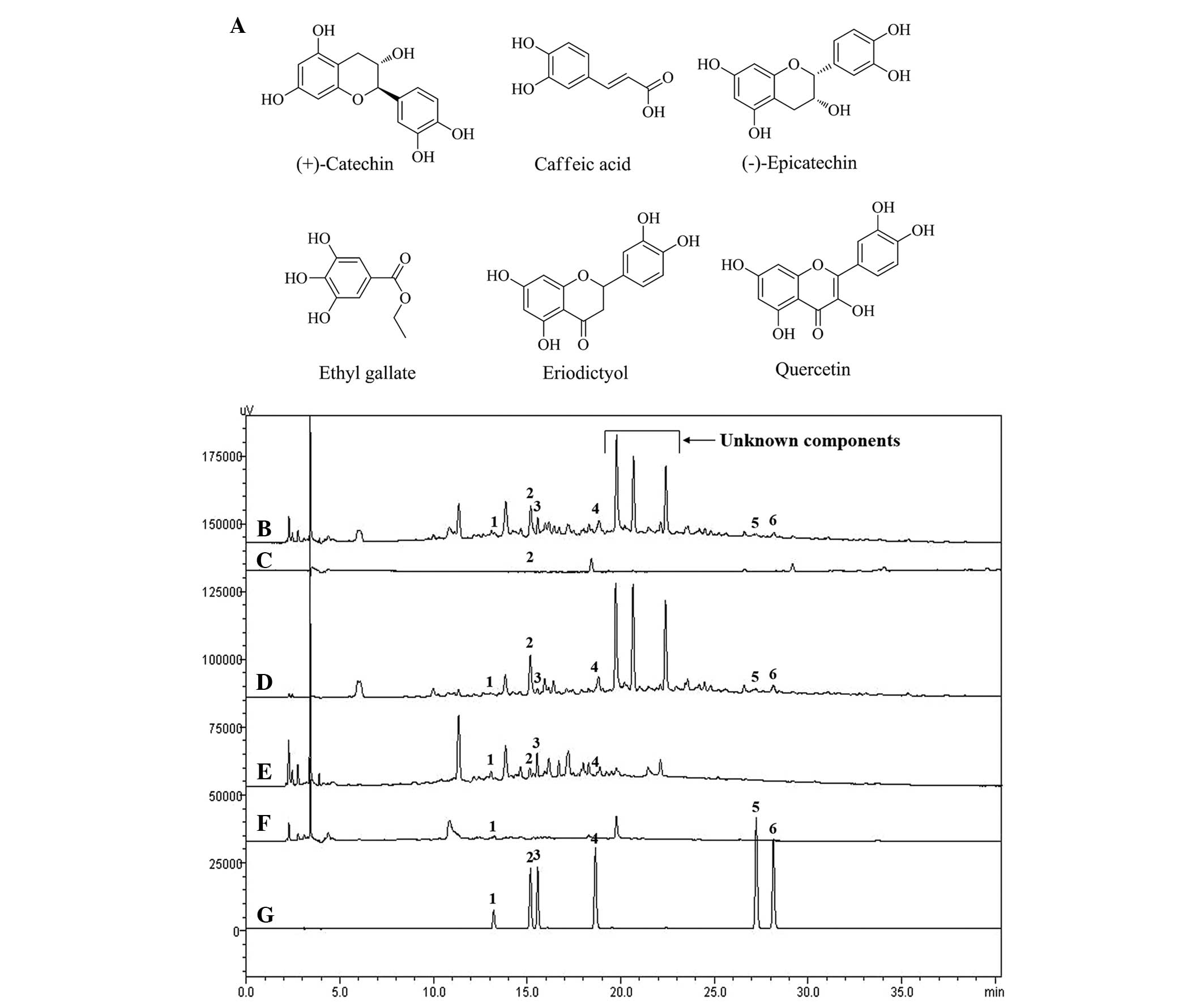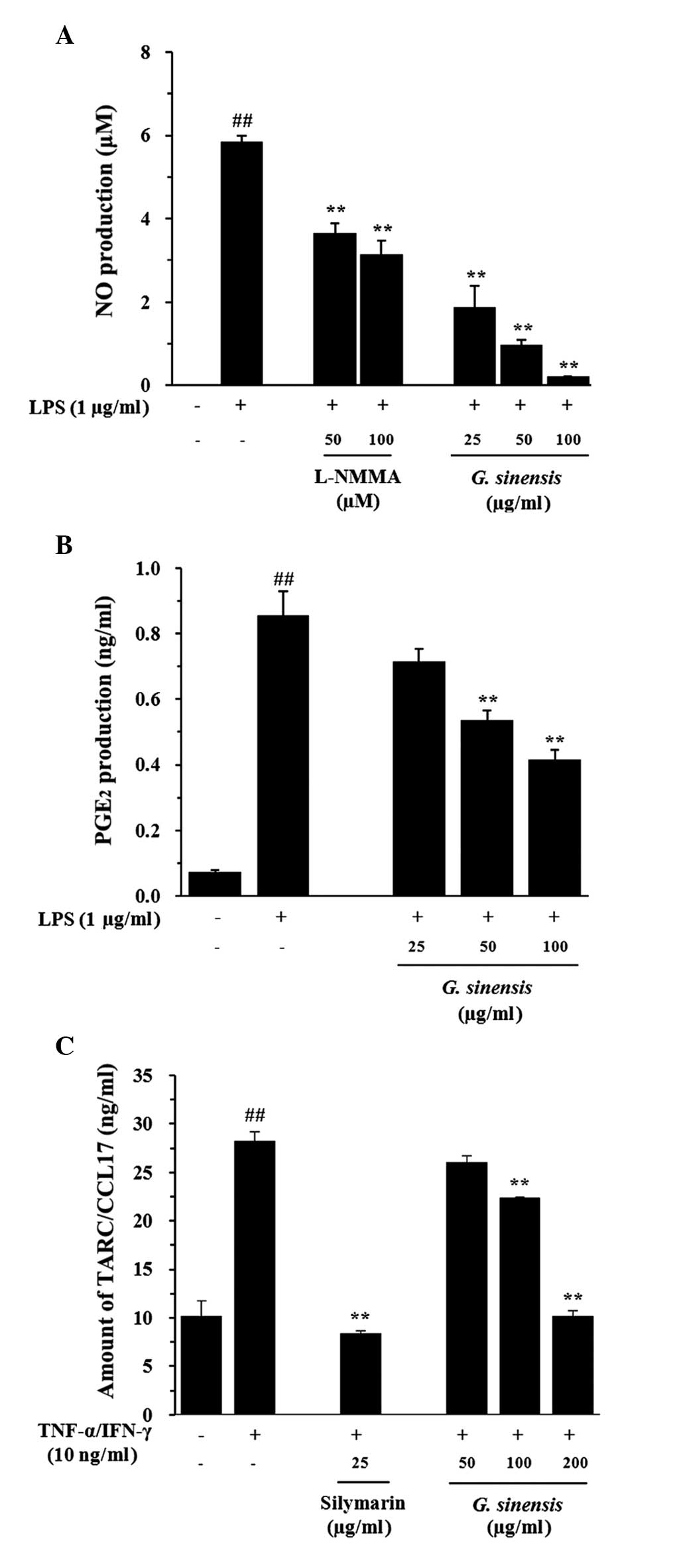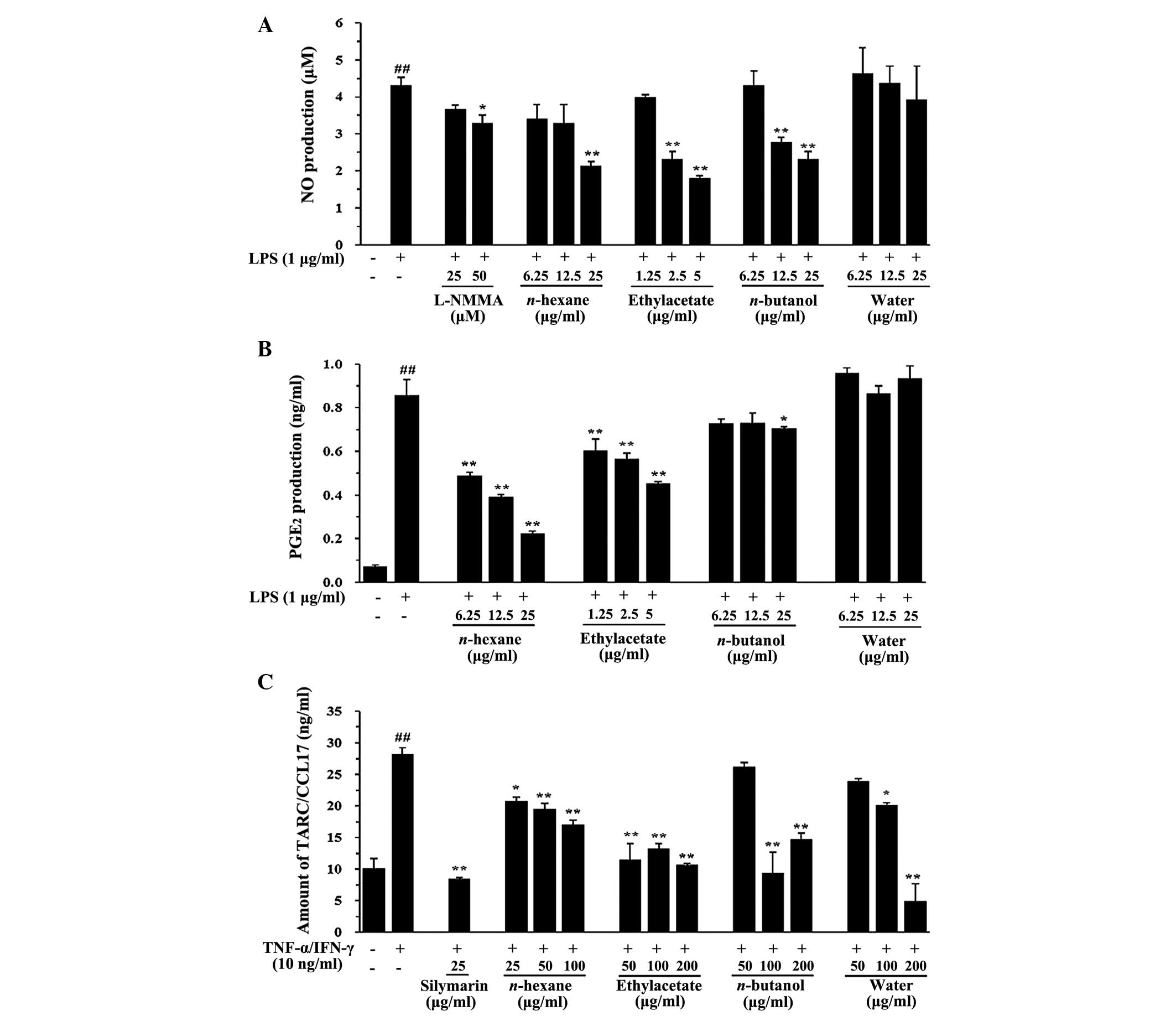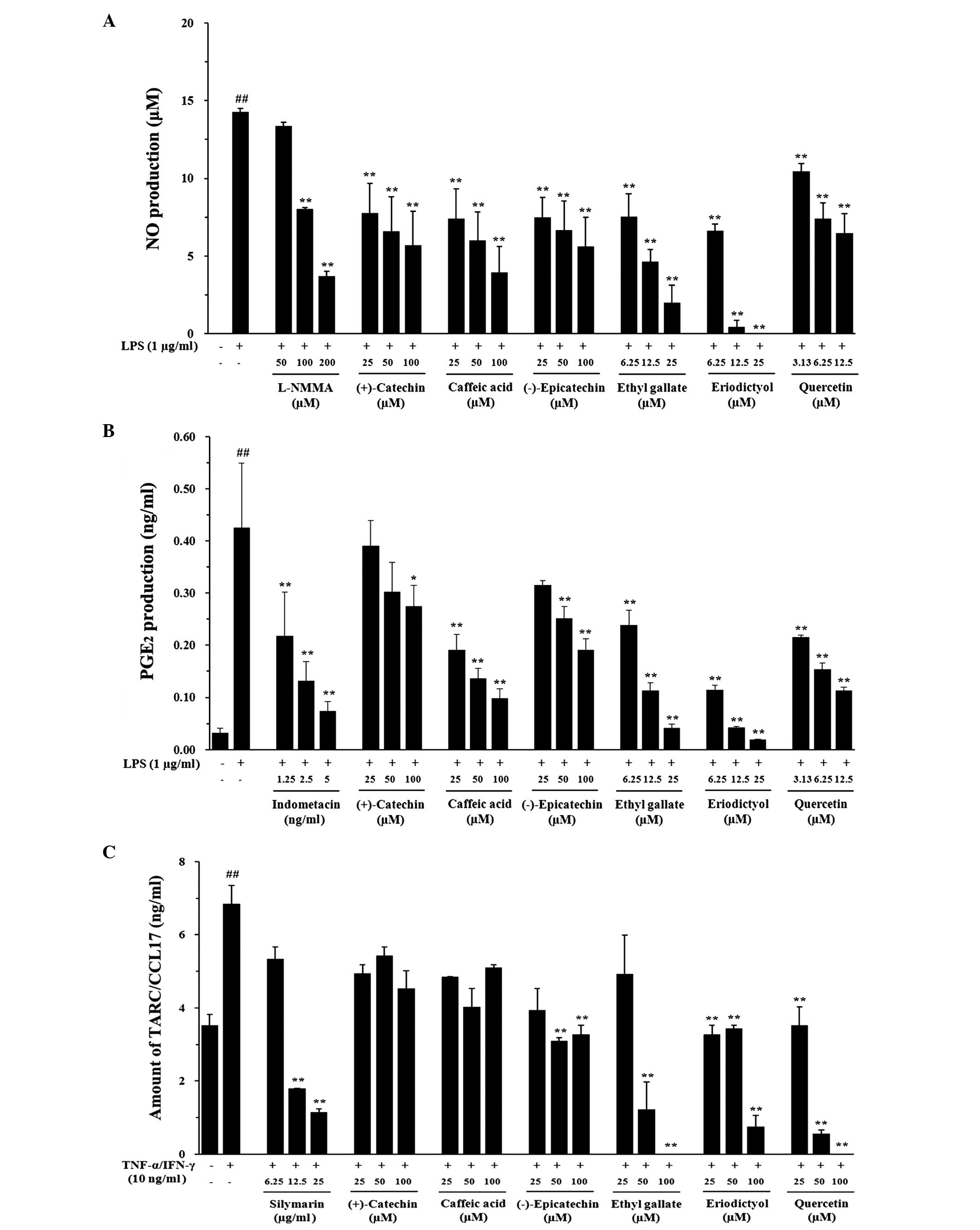|
1
|
Damte D, Reza MA, Lee SJ, Jo WS and Park
SC: Anti-inflammatory activity of dichloromethane extract of
Auricularia auricula-judae in RAW264.7 cells. Toxicol Res.
27:11–14. 2011. View Article : Google Scholar : PubMed/NCBI
|
|
2
|
Duffield JS: The inflammatory macrophage:
A story of Jekyll and Hyde. Clin Sci (Lond). 104:27–38. 2003.
View Article : Google Scholar
|
|
3
|
Gordon S: Alternative activation of
macrophages. Nat Rev Immunol. 3:23–35. 2003. View Article : Google Scholar : PubMed/NCBI
|
|
4
|
Mosser DM and Edwards JP: Exploring the
full spectrum of macrophage activation. Nat Rev Immunol. 8:958–969.
2008. View
Article : Google Scholar : PubMed/NCBI
|
|
5
|
Rossi D and Zlotnik A: The biology of
chemokines and their receptors. Annu Rev Immunol. 18:217–242. 2000.
View Article : Google Scholar : PubMed/NCBI
|
|
6
|
Vestergaard C, Yoneyama H, Murai M,
Nakamura K, Tamaki K, Terashima Y, Imai T, Yoshie O, Irimura T,
Mizutani H and Matsushima K: Overproduction of Th2-specific
chemokines in NC/Nga mice exhibiting atopic dermatitis-like
lesions. J Clin Invest. 104:1097–1105. 1999. View Article : Google Scholar : PubMed/NCBI
|
|
7
|
Hashimoto S, Nakamura K, Oyama N, Kaneko
F, Tsunemi Y, Saeki H and Tamaki K: Macrophage-derived chemokine
(MDC)/CCL22 produced by monocyte derived dendritic cells reflects
the disease activity in patients with atopic dermatitis. J Dermatol
Sci. 44:93–99. 2006. View Article : Google Scholar : PubMed/NCBI
|
|
8
|
Kozma GT, Falus A, Bojszkó A, Krikovszky
D, Szabó T, Nagy A and Szalai C: Lack of association between atopic
eczema/dermatitis syndrome and polymorphisms in the promoter region
of RANTES and regulatory region of MCP-1. Allergy. 57:160–163.
2002. View Article : Google Scholar : PubMed/NCBI
|
|
9
|
Lai P, Du JR, Zhang MX, Kuang X, Li YJ,
Chen YS and He Y: Aqueous extract of Gleditsia sinensis Lam. fruits
improves serum and liver lipid profiles and attenuates
atherosclerosis in rabbits fed a high-fat diet. J Ethnopharmacol.
137:1061–1066. 2011. View Article : Google Scholar : PubMed/NCBI
|
|
10
|
Lim JC, Park JH, Budesinsky M, Kasal A,
Han YH, Koo BS, Lee SI and Lee DU: Antimutagenic constituents from
the thorns of Gleditsia sinensis. Chem Pharm Bull (Tokyo).
53:561–564. 2005. View Article : Google Scholar
|
|
11
|
Zhou L, Li D, Jiang W, Qin Z, Zhao S, Qiu
M and Wu J: Two ellagic acid glycosides from Gleditsia sinensis
Lam. with antifungal activity on Magnaporthe grisea. Nat Prod Res.
21:303–309. 2007. View Article : Google Scholar : PubMed/NCBI
|
|
12
|
Zhou L, Li D, Wang J, Liu Y and Wu J:
Antibacterial phenolic compounds from the spines of Gleditsia
sinensis Lam. Nat Prod Res. 21:283–291. 2007. View Article : Google Scholar : PubMed/NCBI
|
|
13
|
Li WH, Zhang XM, Tian RR, Zheng YT, Zhao
WM and Qiu MH: A new anti-HIV lupane acid from Gleditsia sinensis
Lam. J Asian Nat Prod Res. 9:551–555. 2007. View Article : Google Scholar : PubMed/NCBI
|
|
14
|
Wu J, Li J, Zhu Z, Li J, Huang G, Tang Y
and Gao X: Protective effects of echinocystic acid isolated from
Gleditsia sinensis Lam. against acute myocardial ischemia.
Fitoterapia. 81:8–10. 2010. View Article : Google Scholar
|
|
15
|
Ha HH, Park SY, Ko WS and Kim Y: Gleditsia
sinensis thorns inhibit the production of NO through NF-kappaB
suppression in LPS-stimulated macrophages. J Ethnopharmacol.
118:429–434. 2008. View Article : Google Scholar : PubMed/NCBI
|
|
16
|
Cheng PY, Lee YM, Wu YS, Chang TW, Jin JS
and Yen MH: Protective effect of baicalein against endotoxic shock
in rats in vivo and in vitro. Biochem Pharmacol. 73:793–804. 2007.
View Article : Google Scholar
|
|
17
|
Kundu JK and Surh YJ: Inflammation:
Gearing the journey to cancer. Mutat Res. 659:15–30. 2008.
View Article : Google Scholar : PubMed/NCBI
|
|
18
|
Gröne A: Keratinocytes and cytokines. Vet
Immunol Immunopathol. 88:1–12. 2002. View Article : Google Scholar : PubMed/NCBI
|
|
19
|
Sebastiani S, Albanesi C, De PO, Puddu P,
Cavani A and Girolomoni G: The role of chemokines in allergic
contact dermatitis. Arch Dermatol Res. 293:552–559. 2002.
View Article : Google Scholar : PubMed/NCBI
|
|
20
|
Qi XF, Kim DH, Yoon YS, Li JH, Song SB,
Jin D, Huang XZ, Teng YC and Lee KJ: The adenylyl cyclase-cAMP
system suppresses TARC/CCL17 and MDC/CCL22 production through p38
MAPK and NF-kappaB in HaCaT keratinocytes. Mol Immunol.
46:1925–1934. 2009. View Article : Google Scholar : PubMed/NCBI
|
|
21
|
Saeki H and Tamaki K: Thymus and
activation regulated chemokine (TARC)/CCL17 and skin diseases. J
Dermatol Sci. 43:75–84. 2006. View Article : Google Scholar : PubMed/NCBI
|
|
22
|
Hino R, Kobayashi M, Mori T, Orimo H,
Shimauchi T, Kabashima K and Tokura Y: Inhibition of T helper 2
chemokine production by narrowband ultraviolet B in cultured
keratinocytes. Br J Dermatol. 156:830–837. 2007. View Article : Google Scholar : PubMed/NCBI
|
|
23
|
Appay V and Rowland-Jones SL: RANTES: A
versatile and controversial chemokine. Trends Immunol. 22:83–87.
2001. View Article : Google Scholar : PubMed/NCBI
|













